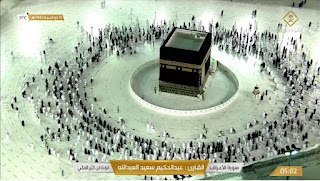Eid al-Adha 2021: Restrictions tight, robots deployed as Muslim pilgrims observe Hajj during 2nd year of pandemic
 |
| Hajj |
Eid al-Adha is also known as the Feast of Sacrifice. The holiday also marks the end of the annual Hajj pilgrimage where Muslims come together to celebrate their faith by honoring and commemorating Prophet Abraham's willingness to sacrifice everything for God.
The annual Hajj pilgrimage, performed over five to six days, is one of the five pillars of Islam, all Muslims are expected to retrace Prophet Muhamad's final pilgrimage at least once in their lives if they have the means to do so.
Muslim pilgrims have ascended Saudi Arabia's Mount Arafat in the high point of this year's Hajj which has been held under coronavirus restrictions for the second year running. Restrictions are tight as the kingdom is hoping to repeat last year's success that saw no coronavirus outbreaks during the feast.
Just 60,000 vaccinated residents aged between 16 and 65 chosen through a lottery from almost 600,000 are participating in this year's Hajj. Foreign pilgrims were barred again due to Covid-19. It's implementing strict Covid-19 measures at the holy sites. Social distancing is a must even in prayer.
The event is usually one of the world's largest annual gatherings. This year the mountain is free of the huge crowds that descend on it in normal years. Nearly 2.5 million muslims around the world missing the annual gathering for the second year because of the pandemic.
 |
| Hajj 2021 |
Worshippers assembled on a 70 meter high hill and its surroundings for hours until the evening.
After spending a night of meditation and introspection in the tent city of Mina, the pilgrims head out to Mount Arafat, some 20 kilometers east of Mecca.
The pilgrims spent time in Arafat with prayers of approval of their pilgrimage and recitation of Quranic Verses until sunset.
They listened to the sermon delivered at Nimra Mosque and perform Zuhr and Asr prayers together.
On sunset they head to Muzdalifah halfway between Arafat and Mina where they sleep before performing the symbolic stoning of the devil.
The pilgrimage this year is happening under exceptional circumstances.
New things have been created for the first time like online submissions for the Hajj ministry and electronic payments.
Pilgrims have also been put in groups with a government guide to ensure safety protocols are followed and a new digital system has been introduced. Worshippers must use a smart card to gain entry to the holy sites and accomodation. It also contains their medical history and services for food and transport.
They also deployed robots to dispense bottles of sacred water from the grand mosque and other robots to dispense disinfectant.



Comments
Post a Comment